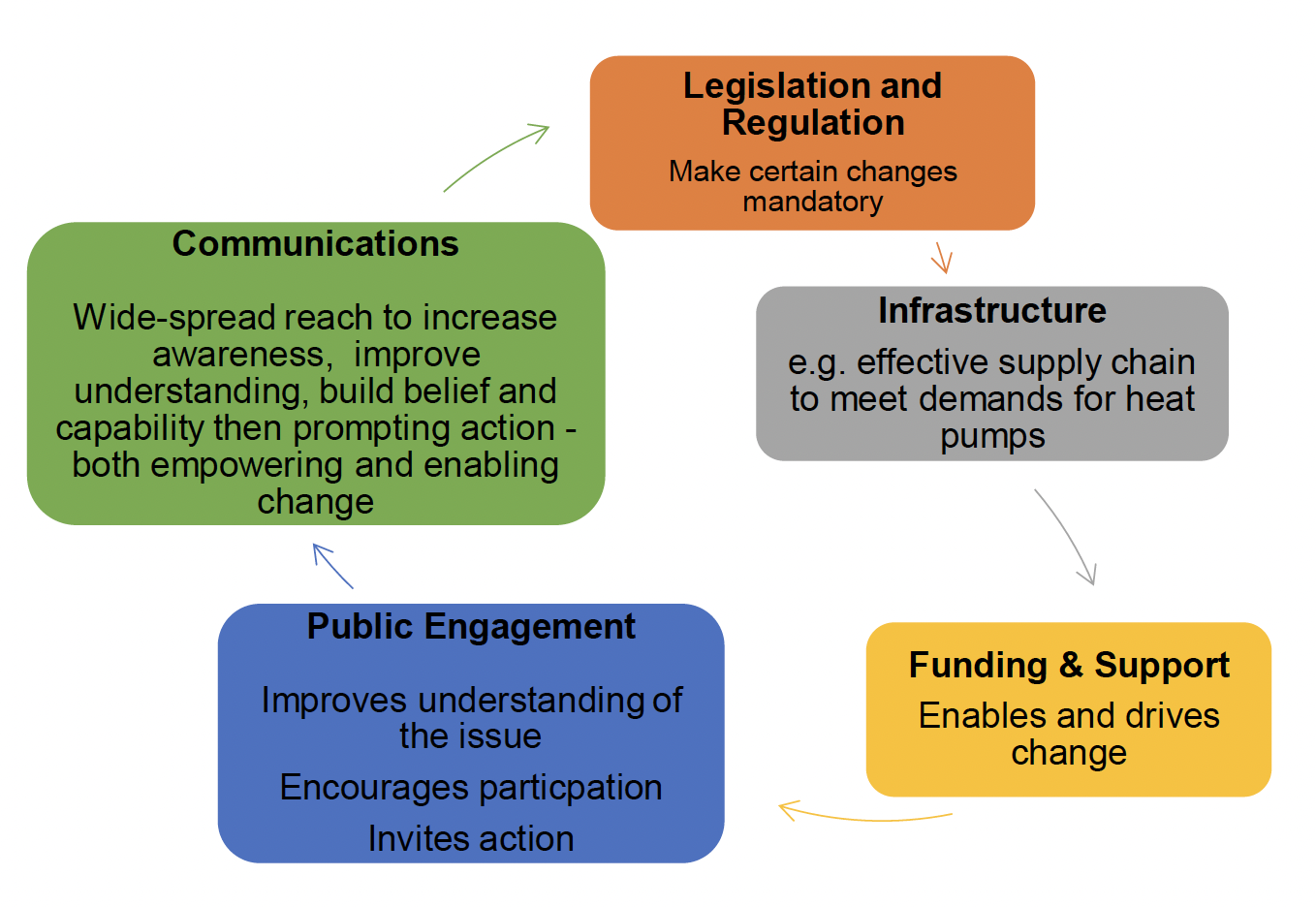Heat in Buildings Bill consultation: business and regulatory impact assessment (partial)
Business and regulatory impact assessment (partial) in support of consultation on proposals for a Heat in Buildings Bill.
Shaping the Consultation
Strategic Oversight Board
5.1 The Scottish Government's Strategic Oversight Board has played an important advisory role in the development of proposals contained in the consultation – helping to develop our thinking and acting as a critical friend.
Qualitative Research
5.2 We have also commissioned research to explore attitudes of homeowners in Scotland to the regulatory standards proposed to be implemented between 2025-2045. It considered both energy efficiency and clean heating in domestic properties. The research explored participants' views on: (i) the concept of net zero, (ii) three proposed scenarios for introducing new regulations, (iii) the support needed to comply with any new regulations, (iv) the fairest way to introduce these regulations in a phased approach and (v) the different ways in which the public can be made aware of the proposed regulations and home upgrades that will be required to reach the net zero targets.
5.3 The findings of this research have helped shape thinking on domestic proposals and has also helped give an informed insight into future work, with the research concluding that there needs to be a large-scale campaign to engage with the public about all required changes and the reasoning behind them. The campaign needs to be widely distributed and must target all aspects of the population; it needs to start with an upfront 'education' piece to help people understand why the changes are required, what net zero means and the impact it will have on people and their properties. The information needs to be distributed as soon as possible, to give people enough time to understand what is going to change and the impact that this will have on them.
Future engagement and consultation
5.4 The consultation will spearhead wider work being undertaken this year on a Public Engagement Strategy (PES) for our Heat in Buildings programme. The PES has been undergoing a series of stakeholder engagements since the end of 2022, gathering views and evidence on the challenges involved in this – with that feedback highlighting disjointedness across existing activities as well as uncertainty for consumers as to what the heat transition will mean in practice.
5.5 A communications and engagement plan supports the launch and public participation of this consultation. The purpose of the upcoming consultation is to listen to what the people of Scotland (as individuals, communities, groups, organisations and businesses) think should be included in a Heat in Buildings Bill, reflecting key concerns and needs of those who will be affected by any future regulations.
5.6 The Scottish Government is determined to manage the decarbonisation of heat in buildings fairly, openly and thoughtfully – with ambition and urgency. However, the current cost of living crisis has a direct impact on the tone and positioning of this issue as well as the receptiveness of people to engage and/or take action.
5.7 We know that we need to create the infrastructure and support that will facilitate widescale behaviour change. Communications to widespread audiences can inform, build belief, motivate, prompt and support the action required to achieve the behaviour change needed to help Scotland reach net zero.
5.8 Many levers will be needed to support a successful consultation, the subsequent development of the Bill and, ultimately, the societal behaviour change required around heat in buildings to 2045.

5.9 The consultation will include in-person public events, alongside targeted engagement with housing and business stakeholders, local authorities and other key stakeholders. Organising and holding public meetings and discussions will ensure as wide a geographical reach as possible and reduce the chance of excluding those unlikely or unwilling to respond or take part in online discussion.
To include (not exhaustive):
Formal 12 week consultation using the Scottish Government's Citizen Space platform
Focused stakeholder engagement (in person & virtual) based on sectoral pillars of the proposal
Broad comms & messaging through Scottish Government comms and social media routes
Face to face engagement across Scotland with communities in a bid to reach beyond normal engagement routes (with assistance from voluntary sector and CoSLA)
Ministerial visits and in person engagement events including with the general public during summer tours
Creation of and dissemination of material to facilitate community groups to facilitate their own discussions and feed back in an informed way
Direct links to broader Heat in Buildings public engagement strategy roll out with associated events, promotion and messaging
5.10 Our consultation will be linked strongly to the Scottish Government's climate change engagement and activity. The consultation's content and proposals will in many ways represent one of the strongest tests to date of wider public awareness and acceptance regarding Scotland's climate change targets and what they will mean in practice.
5.11 Our engagement with business will build on previous consultation with business such as through the non-domestic working group, which included representatives from organisations such as the Federation of Small Businesses and engagement with other organisations representing business, industry and property owners.
Contact
Email: HiBConsultation@gov.scot
There is a problem
Thanks for your feedback